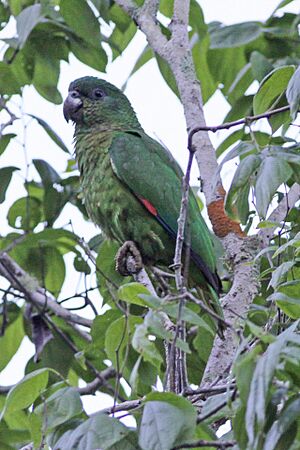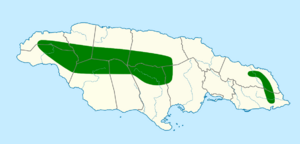Black-billed amazon facts for kids
Quick facts for kids Black-billed amazon |
|
|---|---|
 |
|
| In Cockpit Country, Jamaica | |
| Conservation status | |
| Scientific classification | |
| Genus: |
Amazona
|
| Species: |
agilis
|
 |
|
| Synonyms | |
|
Psittacus agilis Linnaeus, 1758 |
|
The black-billed amazon (Amazona agilis) is a special type of parrot that lives only in Jamaica. It is sometimes called the black-billed parrot. This amazon parrot is mostly green. It has small red patches on its wings and sometimes a few red spots on its head.
You can easily tell it apart from other amazon parrots by its dark bill. Another parrot, the yellow-billed amazon, also lives in Jamaica, but its bill is different. The black-billed amazon is the smallest Amazona parrot, measuring about 25 cm (10 in) long.
Contents
What is the Black-billed Amazon?
How was the Black-billed Amazon named?
In 1751, a British naturalist named George Edwards drew and described this parrot. He called it "The little green parrot." He based his drawing on a live bird he bought in London.
Later, in 1758, a Swedish scientist named Carl Linnaeus gave the parrot its scientific name, Psittacus agilis. The word agilis is Latin and means "nimble" or "active." Today, the black-billed amazon is part of a group of parrots called Amazona. There are no different types or subspecies of this parrot.
What does the Black-billed Amazon look like?
This parrot is smaller than the yellow-billed amazon. It measures about 10.5 and 11.5 inches (27 and 29 centimetres) long. Its bill is very dark grey, almost black, and gets lighter near its head. The skin around its eyes is also dark grey, and its eyes are dark brown.
The parrot's body is mostly green. The feathers on its belly are a lighter, more yellowish green. The feathers on its neck have dark black edges. The feathers covering its ears are blackish. Some of its wing feathers are red, while others are violet-blue and black. The tail is mostly green, with red marks on the side feathers and blue edges on the outer ones. Its feet are greenish-grey. Female parrots look very similar to males, but some of their wing feathers are green instead of red.
What sounds does the Black-billed Amazon make?
When the black-billed amazon flies, its call sounds like a bugle. When it is sitting, it makes growling and rumbling sounds. Often, its calls can be sharp and screechy.
Where does the Black-billed Amazon live?
The black-billed amazon lives only in Jamaica. It prefers to live in mountainous rainforest areas, especially those with limestone rock.
What does the Black-billed Amazon eat?
These parrots eat fruits, seeds, and nuts. They also enjoy cultivated fruits like mangos, papayas, and cucumbers, as well as wild fruits found in their habitat.
Why is the Black-billed Amazon in danger?
The black-billed amazon used to be as common as the yellow-billed amazon. However, its numbers have dropped a lot. This is because of several threats:
- Deforestation: Forests where they live are being cut down.
- Hurricane damage: Strong storms can destroy their forest homes.
- Poaching: Some people illegally hunt these parrots for food.
- Pet trade: Wild parrots are sometimes caught and sold as pets.
These problems break up their forest homes, making it harder for the parrots to survive.



